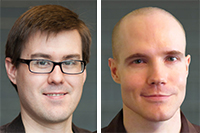Criminal justice faculty help non-violent offenders take first step
adrianaTwo Washington State University criminal justice faculty members are playing key roles in a national effort to free thousands of non-violent prisoners and help them transition smoothly to civilian life.

The First Step Act was signed into law by President Trump late last year. The legislation was designed to create a path to release for prisoners convicted of non-violent drug offenses. The prisoners earn credit for good behavior and are issued a risk profile based on a number of factors. That’s where WSU’s Zach Hamilton and Alex Kigerl come in.
Hamilton received a phone call earlier this year from the National Institute of Justice, requesting his expertise for one of the key components of the First Step Act’s implementation.
“The FSA recognized there is a population in prison that is non-violent,” said Hamilton, an associate professor. “The goal is to release non-violent offenders to communities in ways that are as safe as possible. We created a risk assessment that increases credit given for good behavior and other factors that predict they would be successful in re-engaging (in communities).”
Hamilton says the FSA was necessary due to the fallout from the “war on drugs,” which led to prison populations quadrupling over the past 30 years. The bill had been under consideration for several years before gaining traction last year thanks to bipartisan support.


